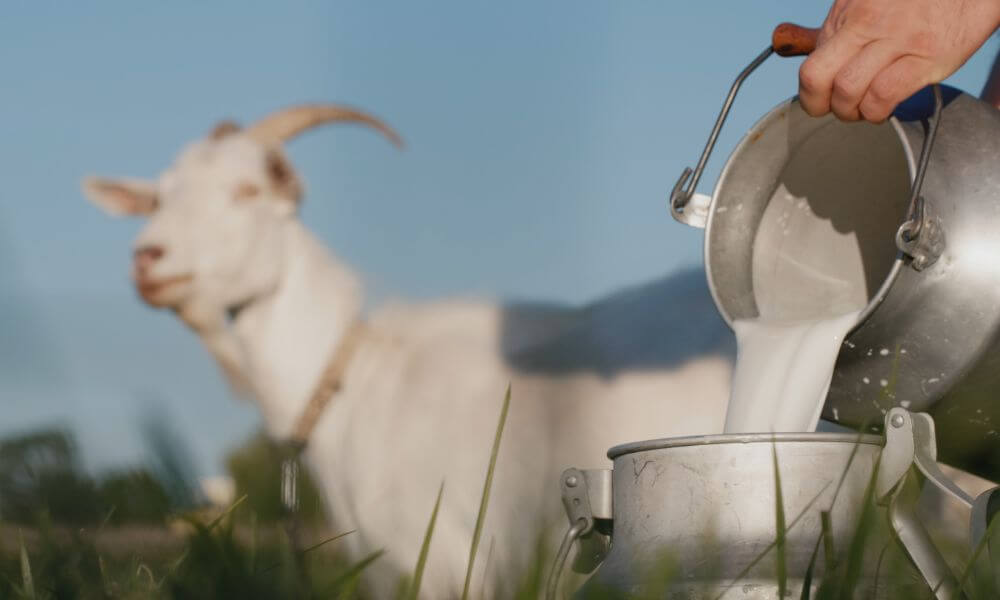The only real difference in the process is going to be in terms of quarantine from the other goats and other similar safety measures.
The other is that you shouldn’t really drink the milk—although some would insist it’s actually fine.
Let’s look at this in more detail.

Should you milk a goat with mastitis?
Mastitis is an umbrella term describing inflamed mammary glands.
It can be clinical or subclinical, meaning it may or may not display symptoms.
It can be caused in various ways—by stress, injury, or bacterial and viral infections.
If a goat has subclinical mastitis and the symptoms are mild, then you’re going to need to milk out the affected area of the udder.
Oxytocin can be used to help remove the milk if you are having trouble doing it. if it’s limited to the udder, you can normally treat it with an intramammary infusion—this can stop it in its tracks.
If it has spread to the rest of the body, you may need a course of penicillin or antibiotics to combat the infection.
Either way, if your goat is a milking doe, then the likelihood is you’re going to need to continue milking her.
If you don’t, her udder will become swollen and painful for her.
In my view, it’s best never to drink the milk in this case.
Some would say, though, that it’s not really any different as long the milk is thoroughly filtered and pasteurized.
I’ll leave it up to your own judgment, but you’d essentially be drinking puss.
How to milk a goat with mastitis?
When it comes to the actual method, again, it’s going to depend.
In severe mastitis cases, the udder is going to become very swollen, even painful to the touch.
However, this will just get worse if you leave it un-milked.
Try and establish if it is causing your goat pain to touch the udders.
If it isn’t, then you can simply go ahead and milk it like your ordinarily would.
Be sure to clean as thoroughly as you ever would, to contain the spread of the mastitis.
If it is in pain from the touch, you might want to consider consulting a vet.
Your best option is to take longer to milk the doe, and allow it to rest a bit after you’ve gotten some out.
You may need to do more milking sessions this way, but you’ll avoid causing too much stress at once from milking and the pain and sensitivity.
Mastitis is a strange condition, then, since it can take such varied forms—so how can you spot it?
| Related Posts |
|---|
How to spot mastitis
Whenever you’re milking your goat, keep a close eye on the udder for signs of swelling.
Look at the milk that’s coming out—is it more like puss than milk?
Is it discolored, or is there blood in it?
All of these are signs of mastitis.
For viral and bacterial infections, perhaps the first thing you’ll notice is a hugely elevated fever.
The goat may also have an accelerated pulse. Look out for any signs of depression-like slow movement, or loss of appetite.
The mammary gland will be hard and swollen, even hot and sensitive to the touch.
These are the primary signs.
How to treat mastitis
Again, treatments are going to vary a lot depending on the kind of mastitis.
For milder forms, a lot of the time when you release the milk the mastitis will eventually go on to correct itself.
For viral and bacterial infections, you’re going to first want to quarantine the infected goats.
Check their fever and pulse as often as you can, and make sure they have plenty of food and water.
Then, you’ll likely need to apply a broad-spectrum antibiotic to fight the infection.
You can often buy these wholesale.
However, ultimately, given that this is a medical issue, the best advice is always to speak to a vet.
They can tell you exactly what form of mastitis you are dealing with, and directly provide you with the tools to treat it.
Mastitis takes a few different forms, then, and how you should approach it is going to depend heavily on which kind you’re dealing with.
If you’re ever in any doubt, you should always consult a vet first and foremost.
They can put you in a position of surety about what you’re dealing with, so there’s no chance you’re taking the wrong approach.
Milking is very likely to be an important part of it, regardless, so with the advice you’ve got here, you should be all set.
